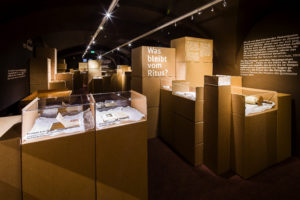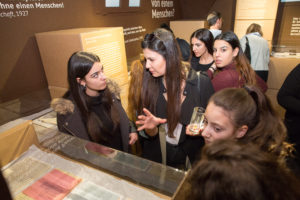
The museum’s current temporary exhibition is titled Übrig. While I don’t know much German, I’ve been told that übrig is a word that doesn’t translate well into English. The exhibition’s official English title is “odd,” which is one way to interpret the word. But übrig also implies a sense of being leftover, or left behind.
I had a chance to visit the Übrig exhibit a few days ago alongside some art history students from Vienna. It’s an exhibition made up of leftovers: the items included are mostly from the museum’s archives but, for one reason or another, they had not previously been displayed.
The items in the Übrig exhibit—though a odd collection—are each fascinating. On display, they are grouped by theme. A collection of locks and keys cut from the doors of Hohenems’ formerly Jewish homes accompanies a ripped piece of Torah scroll that a German soldier had used to send a package home. In another room, a friendship book and a piece of sheet music entitled “Faith-Love-Hope“ (written by a Hohenems emigré living in the United States) create a sense of optimism and resiliency.
Still, the appearance of these objects in the museum signifies a disruption from their intended use. A Torah scroll and mitzvoh plates, for example, do not serve their religious purposes when they are behind the museum glass. The bicycle that sits in another room belonged to a Jewish man who was deported from Hohenems in 1939 and murdered in 1942. No one is riding it.
In some ways, übrig might be an appropriate way to characterize the Jewish history of Hohenems. The town no longer has a Jewish community; the museum itself tells of a past that has been left behind.

After visiting the exhibit, the Viennese students engaged in a discussion about a number of things they had seen. One issue they brought up was the place for the Holocaust in Jewish museums. Obviously, Jewish history is much deeper and richer than those events; on the other hand, failure to include the Holocaust as a part of Jewish history might risk forgetting or denying it.
I was interested in the perspective that the students brought as pupils of art history. I didn’t initially think about the items in the museum (including the Übrig exhibition) as art. However, the idea of art is an interesting way to examine the exhibit. At a basic level, the purpose of art is to be looked at and hopefully challenge the viewer to see something differently. In this way, the Torah scroll or the mitzvoh plates or the bicycle—though deprived of their original uses—take on a new purpose. That purpose involves educating the art students, the young kids who visited the museum earlier that day, the man visiting from Bangladesh who I met yesterday, and so many others.
It might seem odd, but it’s definitely worthwhile.
